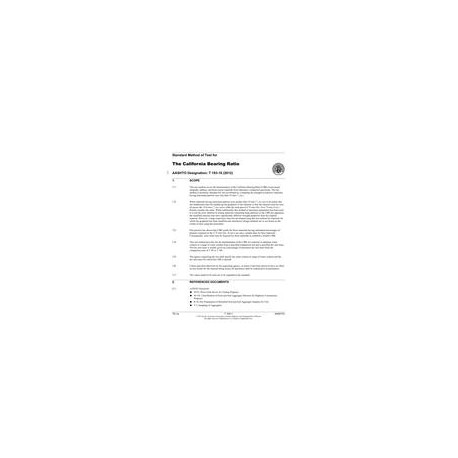Cart 0 Product Products (empty)
No products
To be determined Shipping
$0.00 Total
Product successfully added to your shopping cart
Quantity
Total
There are 0 items in your cart. There is 1 item in your cart.
Total products
Total shipping To be determined
Total
New Reduced price!  View larger
View larger
 View larger
View larger AASHTO T 193-10 (2010)
M00001467
New product
AASHTO T 193-10 (2010) Standard Method of Test for The California Bearing Ratio
standard by American Association of State and Highway Transportation Officials, 2010
In stock
More info
Full Description
This test method covers the determination of the California Bearing Ratio (CBR) of pavement subgrade, subbase, and base/course materials from laboratory compacted specimens. The test method is primarily intended for but not limited to, evaluating the strength of cohesive materials having maximum particle sizes less than 19 mm (3/4 in.).When materials having maximum particle sizes greater than 19 mm (3/4 in.) are to be tested, this test method provides for modifying the gradation of the material so that the material used for tests all passes the 19.0-mm (3/4-in.) sieve while the total gravel 4.75-mm (No. 4) to 75-mm (3-in.) fraction remains the same. While traditionally this method of specimen preparation has been used to avoid the error inherent in testing materials containing large particles in the CBR test apparatus, the modified material may have significantly different strength properties than the original material. However, a large experience base has developed using this test method for materials for which the gradation has been modified, and satisfactory design methods are in use based on the results of tests using this procedure.
Past practice has shown that CBR results for those materials having substantial percentages of particles retained on the 4.75-mm (No. 4) sieve are more variable than for finer materials. Consequently, more trials may be required for these materials to establish a reliable CBR.
This test method provides for the determination of the CBR of a material at optimum water content or a range of water content from a specified compaction test and a specified dry unit mass. The dry unit mass is usually given as a percentage of maximum dry unit mass from the compaction tests of T 99 or T 180.
The agency requesting the test shall specify the water content or range of water content and the dry unit mass for which the CBR is desired. Unless specified otherwise by the requesting agency, or unless it has been shown to have no effect on test results for the material being tested, all specimens shall be soaked prior to penetration.

